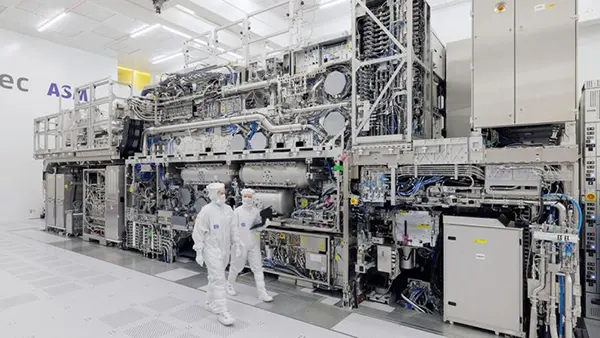How ASML Became Europe’s Most Important Tech Company You’ve Never Heard Of
ASML is not a household name like Apple or Samsung, yet this Dutch company holds a monopoly on one of the most complex and essential technologies in modern electronics: EUV lithography machines. Without ASML, the production of advanced microchips would be virtually impossible. As of February 2025, ASML stands as a strategic linchpin in the global semiconductor supply chain, drawing attention from policymakers, tech giants, and investors alike.
The Hidden Giant of Semiconductor Manufacturing
Founded in 1984 as a joint venture between Philips and ASM International, ASML originally focused on step-and-repeat systems for the semiconductor industry. However, it wasn’t until the early 2000s that the company began investing heavily in extreme ultraviolet (EUV) lithography—a technology that would later define its global dominance. Today, ASML is the sole supplier of EUV machines, which are critical for manufacturing chips at nodes below 7nm.
Despite its relatively low public profile, ASML’s technology is embedded in virtually every smartphone, computer, and server used around the world. Each EUV machine, priced around $150 million, contains over 100,000 components and takes multiple aircraft to transport. The precision required to operate them is so intense that only a handful of companies—such as TSMC, Samsung, and Intel—are even capable of using them effectively.
By controlling this indispensable equipment, ASML has quietly become one of the most valuable companies in Europe, with a market capitalisation exceeding €400 billion. Yet, because it operates in the B2B space, most consumers remain unaware of its critical role.
Why EUV Lithography Changed the Game
Traditional deep ultraviolet (DUV) lithography faced physical limitations as chipmakers attempted to pack more transistors into smaller spaces. EUV, with its 13.5-nanometre wavelength, allowed manufacturers to etch finer details on silicon wafers. This breakthrough meant faster, more energy-efficient chips—essential for AI, 5G, and high-performance computing.
ASML’s breakthrough came after two decades of R&D and partnerships with key players like Zeiss and the European Union. These machines use tin droplets and lasers to create plasma hotter than the sun’s surface, generating EUV light, which is then reflected by a system of mirrors to etch circuits onto wafers. It’s a scientific and engineering marvel unmatched in complexity.
By achieving what no other company could, ASML became a technological gatekeeper. As of 2025, no rival has matched its capability in EUV lithography. This exclusivity gives ASML both immense power and strategic vulnerability, especially in the context of U.S.-China trade tensions.
Geopolitical Significance in a Fragmented World
ASML’s dominance has not gone unnoticed by governments. In recent years, the Dutch government—under pressure from Washington—has restricted the export of advanced EUV machines to China. This move places ASML at the heart of the geopolitical tug-of-war between the U.S. and China over technological supremacy.
Beijing has invested heavily in developing its own EUV capabilities, but experts agree it could take a decade or more to approach ASML’s level of sophistication. Meanwhile, ASML remains a strategic asset in Europe’s industrial and security frameworks. The company’s operations are closely monitored and increasingly safeguarded against cyber threats and industrial espionage.
While other companies innovate in software or design, ASML’s strength lies in the physical infrastructure that enables digital progress. Without access to EUV, national strategies for semiconductor independence face an uphill battle. This reality has made ASML a frequent topic in high-level discussions within NATO and the European Commission.
Impact on Global Supply Chains
The global chip shortage during the COVID-19 pandemic exposed just how dependent the world is on a small number of suppliers. ASML, with its long lead times and limited production capacity, became a bottleneck for the entire semiconductor industry. Each year, it delivers only about 50 EUV systems—far fewer than demand would suggest.
This scarcity has forced manufacturers to queue for months, sometimes years, to secure a machine. The consequence is a ripple effect that touches everything from smartphones to electric vehicles. As companies race to expand their fabrication capacity, ASML’s order backlog continues to grow.
In response, ASML announced in 2024 a significant expansion of its production facilities in Veldhoven and new investments in supply chain resilience. Still, industry insiders believe true scalability will take years, reinforcing the company’s unique position in the ecosystem.

The Road Ahead: Challenges and Innovation
Despite its success, ASML faces challenges on several fronts. The rising complexity of EUV systems demands even more precise engineering, higher R&D costs, and tighter integration with suppliers. Moreover, the political pressure to restrict access to certain markets may impact its growth trajectory.
To stay ahead, ASML is already working on the next generation of lithography: High-NA EUV. These machines promise even smaller transistors and better performance, aligning with industry goals for 2nm and sub-2nm process nodes. The first prototypes have already been shipped to major clients for early testing as of January 2025.
Maintaining talent is another key issue. The company employs over 40,000 people worldwide and competes globally for specialists in optics, physics, and mechanical engineering. Partnerships with universities and governments are seen as crucial for sustaining innovation.
Will ASML Remain Unchallenged?
For now, ASML enjoys a monopoly that no competitor is poised to disrupt. However, the stakes are high, and rival nations are ramping up investments in alternative technologies. Companies in Japan, South Korea, and China are exploring non-EUV paths such as nanoimprint lithography or multi-beam direct-write approaches.
Nonetheless, experts believe these alternatives are unlikely to replace EUV in the near future. The sheer amount of capital, know-how, and time required to build a comparable system creates a high barrier to entry. ASML’s head start—built on decades of research—offers it a durable advantage.
Still, the company cannot afford complacency. In a world where technological supremacy equals political power, ASML sits at a precarious intersection of innovation, diplomacy, and economics. Its ability to adapt and lead will determine whether it remains the quiet giant or becomes a target of global rivalries.
